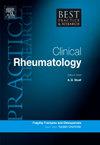超声和磁共振成像在评估系统性红斑狼疮肌肉骨骼受累中的作用:最近进展和见解的回顾。
IF 4.8
2区 医学
Q1 RHEUMATOLOGY
Best Practice & Research in Clinical Rheumatology
Pub Date : 2025-09-01
DOI:10.1016/j.berh.2025.102042
引用次数: 0
摘要
系统性红斑狼疮(SLE)是一种以多种表现为特征的自身免疫性疾病,肌肉骨骼(MSK)受累是最普遍和使人衰弱的疾病之一。超声和磁共振成像(MRI)等先进成像技术越来越多地挑战了SLE关节炎是轻度和主要非糜烂性的传统观念。这些模式在有症状和无症状的患者中都显示了亚临床炎症改变、结构损伤和关节周围软组织受累。超声在检测滑膜炎、腱鞘炎和腱鞘异常方面非常敏感,在没有临床关节炎的患者中也是如此,这为亚临床疾病活动提供了见解,否则这些疾病将无法诊断。MRI虽然由于成本和可及性不太常用,但仍然是检测骨髓水肿、细微侵蚀和炎症变化的金标准。最近的研究表明,通过影像学识别的亚临床滑膜炎和腱鞘炎可能先于一些患者的临床症状,强调了这些发现的潜在预后价值。骨侵蚀,曾经被认为是罕见的SLE,现在观察到各种关节病亚型,挑战传统的分类。影像学也显示了骨骺和肌肉受累的存在,扩大了对sle相关MSK病理的理解。这篇综述强调了超声和MRI在SLE中MSK累及的诊断、监测和管理中的变革性作用。将影像学结果纳入常规实践和更新的分类标准可能有助于早期干预和个性化治疗。虽然用于检测SLE中肌肉骨骼受累的成像技术取得了重大进展,但在标准化方案以及将发现与疾病活动和结果相关联方面仍然存在挑战。需要进一步的研究来解决这些挑战,并进一步探讨影像学结果的预后意义。本文章由计算机程序翻译,如有差异,请以英文原文为准。
The role of ultrasound and magnetic resonance imaging in the assessment of musculoskeletal involvement in systemic lupus erythematosus: A review of recent advances and insights
Systemic lupus erythematosus (SLE) is an autoimmune disease characterized by diverse manifestations, with musculoskeletal (MSK) involvement being one of the most prevalent and debilitating. Traditional perceptions of SLE arthritis as mild and primarily non-erosive are increasingly challenged by advanced imaging techniques, such as ultrasound and magnetic resonance imaging (MRI). These modalities have revealed subclinical inflammatory changes, structural damage, and peri-articular soft tissue involvement in both symptomatic and asymptomatic patients. Ultrasound is highly sensitive in detecting synovitis, tenosynovitis, and entheseal abnormalities, also in patients without clinical arthritis, offering insights into subclinical disease activity that would otherwise remain undiagnosed. MRI, while less commonly used due to cost and accessibility, remains the gold standard for detecting bone marrow oedema, subtle erosions, and inflammatory changes.
Recent studies demonstrate that subclinical synovitis and tenosynovitis, identified through imaging, may precede clinical symptoms in some patients, emphasizing the potential prognostic value of these findings. Bone erosions, once thought rare in SLE, are now observed across various arthropathy subtypes, challenging traditional classifications. Imaging has also revealed the presence of entheseal and muscle involvement, expanding the understanding of SLE-related MSK pathology.
This review highlights the transformative role of ultrasound and MRI in diagnosing, monitoring, and managing MSK involvement in SLE. Incorporating imaging findings into routine practice and updated classification criteria may enable early intervention and personalized treatment. While significant advancements have been made in imaging technologies for detecting musculoskeletal involvement in SLE, challenges remain in standardizing protocols and correlating findings with disease activity and outcomes. Further research is needed to address these challenges and further explore the prognostic significance of imaging findings.
求助全文
通过发布文献求助,成功后即可免费获取论文全文。
去求助
来源期刊
CiteScore
9.40
自引率
0.00%
发文量
43
审稿时长
27 days
期刊介绍:
Evidence-based updates of best clinical practice across the spectrum of musculoskeletal conditions.
Best Practice & Research: Clinical Rheumatology keeps the clinician or trainee informed of the latest developments and current recommended practice in the rapidly advancing fields of musculoskeletal conditions and science.
The series provides a continuous update of current clinical practice. It is a topical serial publication that covers the spectrum of musculoskeletal conditions in a 4-year cycle. Each topic-based issue contains around 200 pages of practical, evidence-based review articles, which integrate the results from the latest original research with current clinical practice and thinking to provide a continuous update.
Each issue follows a problem-orientated approach that focuses on the key questions to be addressed, clearly defining what is known and not known. The review articles seek to address the clinical issues of diagnosis, treatment and patient management. Management is described in practical terms so that it can be applied to the individual patient. The serial is aimed at the physician in both practice and training.

 求助内容:
求助内容: 应助结果提醒方式:
应助结果提醒方式:


